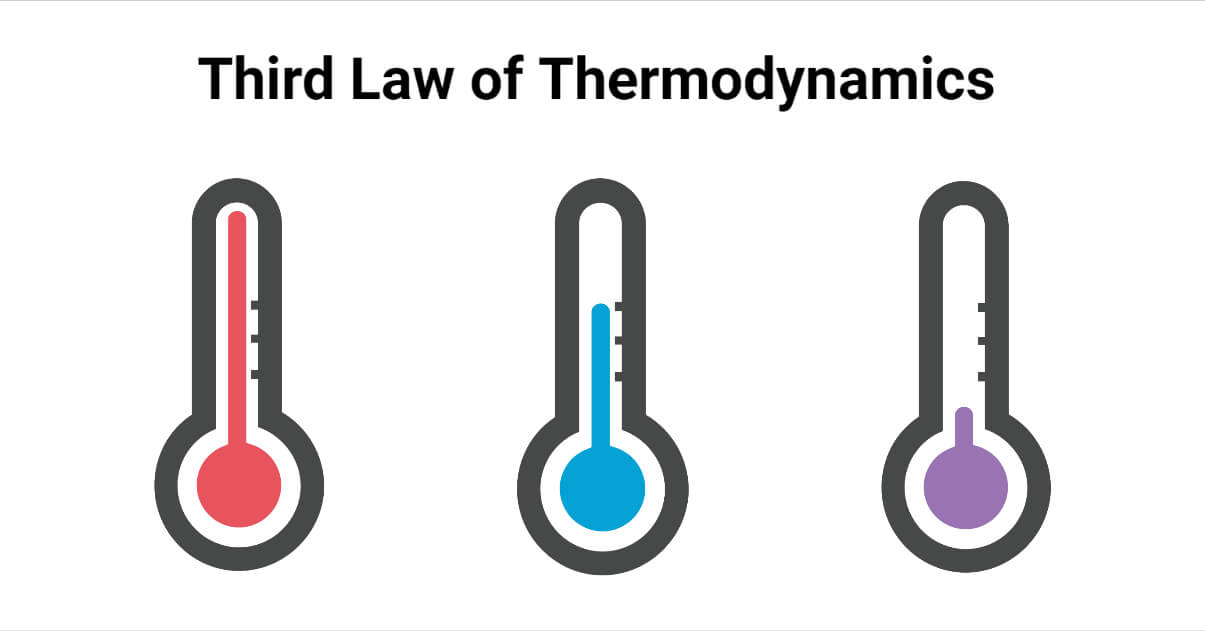The third law of thermodynamics is concerned with how systems behave as they approach absolute zero. It describes the relationship between heat and entropy at the absolute lowest temperature for crystals, which are defined as any solid material composed of atoms arranged in a definite, symmetrical pattern.

What is Third Law of Thermodynamics?
The third law of thermodynamics states that the entropy of a perfect crystal at a temperature of zero Kelvin (absolute zero) is equal to zero.
The third law of thermodynamics states that as a system’s temperature approaches absolute zero, its absolute entropy approaches a constant value. In the previous example, where the system was the entire universe, this was true. It is also true for smaller closed systems: chilling a block of ice to colder and colder temperatures slows down its internal molecular motions until they reach the least disordered state physically possible, which can be described using a constant value of entropy.
The majority of entropy calculations are concerned with entropy differences between systems or states of systems. This third law of thermodynamics differs in that it leads to well-defined values of entropy as values on the Kelvin scale.
Let us have a small sneak peek about entropy as it is widely useful in the laws of thermodynamics.
Entropy
Entropy, represented by the letter ‘S,’ is a measure of disorder/randomness in a closed system. It is proportional to the number of microstates (a fixed microscopic state that a system can occupy) accessible to the system; that is, the greater the number of microstates a closed system can occupy, the greater its entropy. The ground state of the system is the microstate in which the energy of the system is at its lowest. Entropy is a measure of the universe’s disorder. A high entropy object or substance is highly disorder.
- When you organize things, such as putting your child’s toys in a box, you reduce entropy.
- Or consider the outcome of a farmer’s market at the end of the day: that’s a lot of entropy. Unfortunately, the heat in your muscles is also producing entropy.
- The universe’s entropy can only increase. It can never decrease.
- A solid is more orderly than a liquid because its molecules are arranged in neat rows.
Controversy on Third Law of Thermodynamics
The third law of thermodynamics began with the so-called heat theorem, or Wärmetheorem in German, which was discovered in 1906 by Walther Hermann Nernst, who had been appointed to the University of Berlin’s Second Chemical Institute and given permanent membership in the Prussian Academy of Sciences the previous year. The third law is also referred to as Nernst’s postulate or Nernst’s theorem.
This theorem, along with Einstein’s 1907 paper demonstrating that quantum mechanics predicts that the specific heats of solids will tend towards absolute zero when temperatures near absolute zero, appeared to reinforce each other. This was significant to Nernst because his theorem was not clearly a third law of thermodynamics because it could not be deduced from the first two laws of thermodynamics. Although there was debate surrounding Nernst’s work when he received the Nobel Prize in Chemistry in 1920, Theodore Richards, an American chemist, claimed that he, not Nernst, had discovered the third law of thermodynamics.
Statements of Third Law of Thermodynamics
Nernst Theorem
At absolute zero, a chemical reaction between pure crystalline phases produces no change in entropy. It is impossible to reduce a system’s absolute entropy to zero in a finite number of operations. The third law of thermodynamics enables us to calculate the absolute value of entropy, which is impossible in classical thermodynamics.
Planck Statement
Max Planck proposed the third law of thermodynamics in 1911 as a condition for the destruction of all bodies’ entropy as the temperature approaches absolute zero.
According to Plank, entropy tends to be a constant independent of the other thermodynamic variables in any system in equilibrium where the temperature approaches zero.
Absolute Zero Inaccessibility Theorem
“A process capable of reducing the temperature of a system to absolute zero would require an infinite number of steps to reach absolute zero.”
Consequences of Third Law of Thermodynamics
Two important consequences of Third Law of Thermodynamics are:
- The behavior of heat capacities as the temperature approaches zero, and the fact that we cannot reach absolute zero.
- Provides a fixed reference point from which we can measure the absolute entropy of any substance at any temperature.
References
- Aston, J. and Fritz, J.J., Thermodynamics and Statistical Mechanics, John Wiley and Sons, Inc., New York, 1959.
- Atkins, P.W. and Julio de Paulo, Atkins’ Physical Chemistry, Oxford University Press, UK, Indian Edition 9, 2011.
- R. Chang, “Physical Chemistry for the Chemical and Biological Sciences”, University Science Books, Sausalito, California (2000).
- https://byjus.com/chemistry/third-law-of-thermodynamics/
- https://www.livescience.com/50942-third-law-thermodynamics.html
- https://www.sciencedirect.com/topics/physics-and-astronomy/third-law-of-thermodynamics
